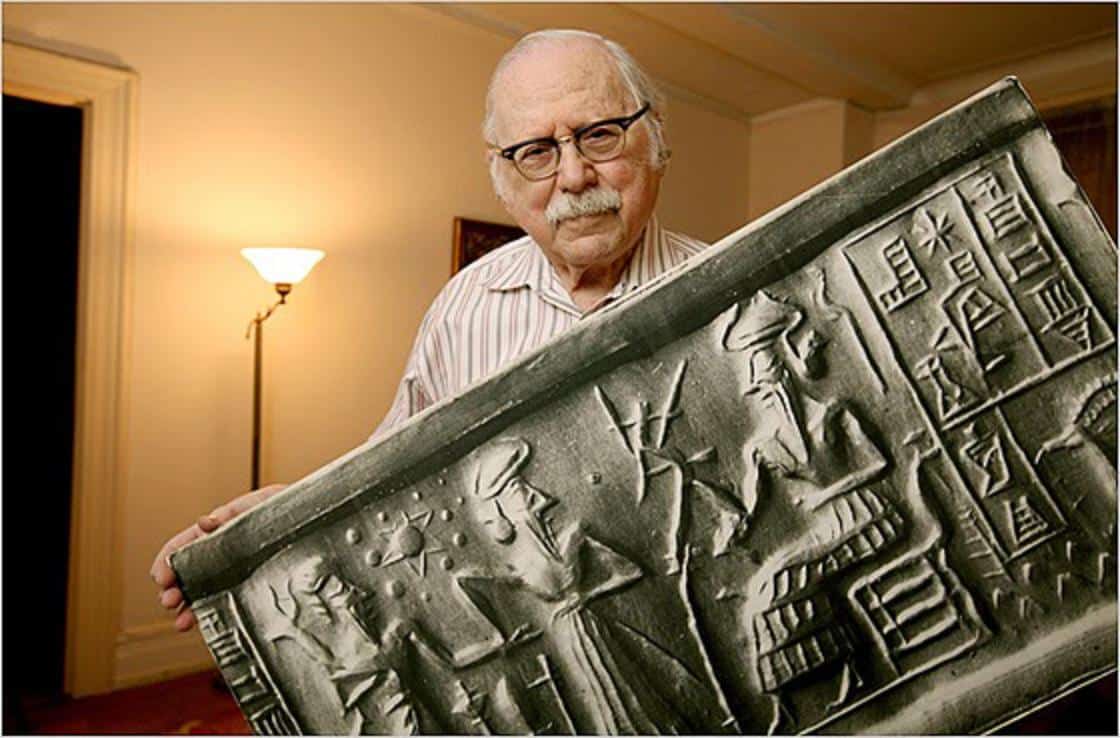
While you are learning about the Anunnaki, there is one name which you are going to encounter again and again: Zecharia Sitchin.
Who was Zecharia Sitchin? That depends in part upon who you ask. To some, he was a brilliant scholar with revolutionary ideas about the ancient Sumerian and Babylonian gods. To others, he was a pseudo-scientist and pseudo-historian with delusional thinking.
Regardless, one thing is certain, and that is that Zecharia Sitchin was a hugely influential man who changed the way that many people view human life, human nature, and our role in the cosmos. He was the leading author on the Anunnaki, and one of the most important proponents of the belief in ancient astronauts.
In this guide, I will introduce you to some of Zecharia Sitchin’s books. But first, let’s go over a brief biography of his life.
Zecharia Sitchin’s Life
Zecharia Sitchin was born on July 11th, 1920 in the Azerbaijan SSR. He grew up in Mandatory Palestine. Having a chance to live in the Near East, he developed a passion for its history and languages.
During that time, he picked up a great deal of Hebrew as well as other European and Semitic languages. He later studied at the University of London, where he earned a degree in economic history.
Following his graduation, Sitchin worked as a journalist and editor in Israel. In 1952, he moved to New York. After becoming an executive for a shipping company, he took the opportunity to travel and visit archaeological sites. During this time he also taught himself Sumerian cuneiform.
In 1976, Sitchin published his first book on ancient astronauts, The 12th Planet. This groundbreaking title pooled together his research into ancient tablets and texts with his theories about alien visitors who created human life on earth long ago. It was a groundbreaking title and the first of the Earth Chronicles volumes, a set which would eventually span 7 books. These were accompanied by the Companion volumes, the Earth Chronicles expeditions, and a couple of novels.
Sadly the world lost Zecharia Sitchin on October 9th, 2010. His legacy however lives on.
Key Ideas
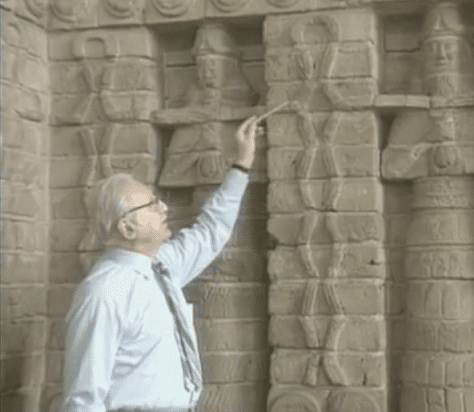
Sitchin’s key claims and beliefs were as follows:
- The ancient Mesopotamian gods were actually real, only they were not actually gods. They were alien beings. Lacking the language to discuss extraterrestrial life, the ancients simply referred to them as “gods.”
- There is another planet in our solar system which is presently undiscovered by modern scientists. It follows a slow elliptical orbit somewhere beyond Neptune, and crosses into the inner solar system ever 3,600 years or so. This planet may be referred to as Marduk or Planet Nibiru.
A collision between Nibiru and Tiamat (another hypothesized planet which no longer exists—if it ever did) created the Earth as well as the asteroid belt and the comets. This is the “twelfth planet” (the sun and moon are counted along with Pluto).
- Nibiru is home to a race of extraterrestrials. These are the Anunnaki of Sumerian lore, and may also be the Nephilim as referenced in Genesis.
- The Anunnaki visited earth during the times of the ancient Sumerians. Searching for gold to sustain their homeworld, they needed workers to help them mine it. For this purpose, they genetically engineered a slave race—humans. This corresponds with the Mesopotamian story involving Enki and Enlil.
- Human civilization was for a time overseen entirely by alien forces. Human kings were appointed however to serve as intermediaries. Eventually however conflict set in between the Anunnaki themselves. The “evil wind” written about in the Lament for Ur is actually nuclear weapon fallout.
- The Great Flood as discussed in Judeo-Christian and Mesopotamian lore was actually caused by Nibiru the last time it came close to Earth.
- The next time Nibiru returns, it may again cause global devastation. This could take the form of natural disaster and/or the return of our alien overlords.
The Anunnaki are sometimes referred to as “reptilians.” While they are humanoid, they may have reptilian attributes and may also be shapeshifters. Many people believe that they walk among us still, disguised as human beings.
Evidence for Zecharia Sitchin’s Ideas
Is there any actual historical or scientific evidence that Zecharia Sitchin’s ideas are true? Well, there is certainly no hard proof. But there are some interesting parallels in astronomy:
- The idea that Tiamat and Nibiru collided to form the Earth, moon, asteroid belt and comets may actually hold water. Modern astronomers do think that an event like this may have led to the formation of the moon. This is referred to as the “giant impact hypothesis.”
- In 2016, researchers at the California Institute of Technology discovered compelling mathematical evidence for a “Ninth Planet” with a long orbit and a huge mass. Could it be Nibiru? It certainly seems possible. This is quite an incredible discovery; read all about it here.
Beyond that, most of the evidence for Zecharia Sitchin’s theories comes from the ancient tablets he has studied and the parallels he has discovered in religious and historical texts.
Criticism for Zecharia Sitchin’s Ideas
Zecharia Sitchin was actually something of a pioneer when it came to Sumerian translations. Back when he did his work, very few people knew how to read it. In 2006 however, a book called Sumerian Lexicon was published which has helped to broaden access to Sumerian texts. A number of academics have spotted inaccuracies in Sitchin’s translations.
Some of these “inaccuracies” are perhaps interpretive as well—Sitchin tends toward literalism, both in how he perceives images and words.
Some scholars also contend that in doing so, he ignores known historical and mythological contexts in favor of his own views.
Despite this, Sitchin has had a huge influence on popular culture—and I would argue his relevance extends even further than that. Was the man 100% right about everything? Of course not—and nobody could be. We are all just trying to piece together the puzzle of our place in the universe. The bottom line is that Sitchin has provided us with some intriguing pieces to that puzzle.
Zecharia Sitchin’s Anunnaki Books
Zecharia Sitchin’s principle bibliography consists of the Earth Chronicles volumes, which he started in 1976 and concluded in 2007:
- The 12th Planet, 1976
- The Stairway to Heaven
- The Wars of Gods and Men, 1985
- The Lost Realms, 1990
- When Time Began, 1993
- The Cosmic Code, 1998
- The End of Days: Armageddon and Prophecies of the Return, 2007
Along with these are four companion volumes:
- Genesis Revisited: Is Modern Science Catching Up With Ancient Knowledge?, 1990
- Divine Encounters: A Guide to Visions, Angels and Other Emissaries, 1995
- The Earth Chronicles Handbook, 2009
- There Were Giants Upon the Earth: Gods, Demigods, and Human Ancestry: The Evidence of Alien DNA, 2010
Then there are the Earth Chronicles Expeditions:
- The Earth Chronicles Expeditions, 2004
- Journeys to the Mythical Past, 2007
And two novels:
- The Lost Book of Enki: Memoirs and Prophecies of an Extraterrestrial god, 2001
- The King Who Refused to Die: The Anunnaki and The Search for Immortality, 2013
There is also a DVD series:
- Are We Alone in the Universe? (based on Genesis Revisited), documentary, 1978 (2003 DVD release)[37]
- An Evening with Zecharia Sitchin, lecture and slide presentation, 1997
- A Talk From The Heart! lecture and slide presentation, 2006
- Signs of the Return, lecture and slide presentation, 2009
- 2012—the End of Days? lecture and slide presentation, 2010
- Zecharia at 90—Farewell Address, lecture, 2010
Start Here:
Feeling overwhelmed by so many Zecharia Sitchin books?
I recommend simply starting with the first of the Earth Chronicles volumes, The 12th Planet.
The 12th Planet
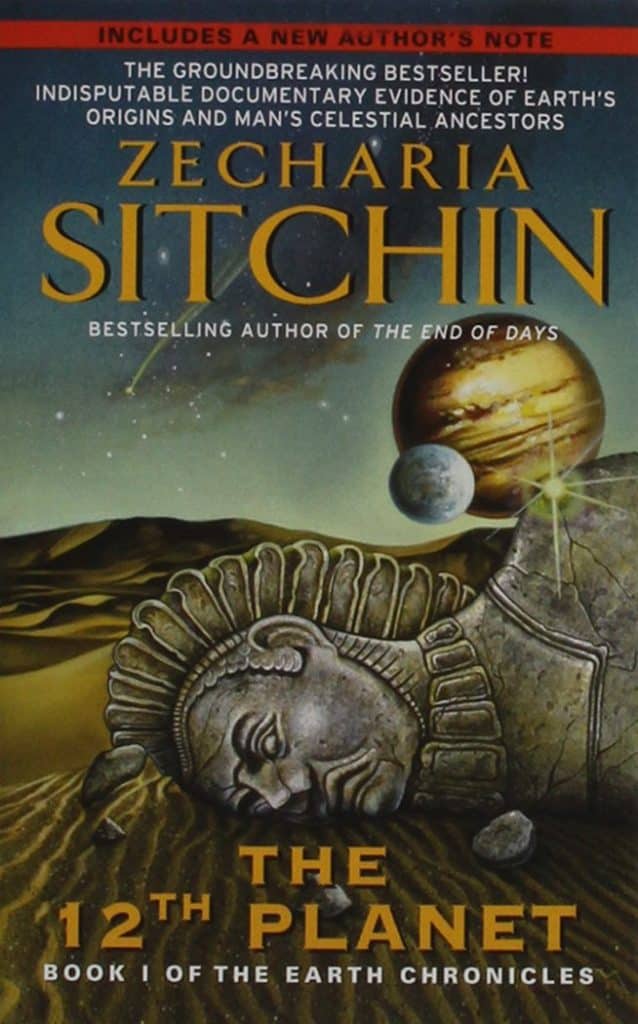
This book lays the groundwork for all of Sitchin’s theories.
In its pages, he explains the parallels between the Sumerian and Babylonian clay tablet texts and Judeo-Christian lore, as well as how those myths fit into the alien narrative of ancient astronauts. R
eading this volume, you get a great feel for just how thorough Sitchin is as a scholar, and you get a thorough understanding of the Anunnaki theory.
Basically … if even 10% of this book is accurate, the implications are earth-shaking.
After you read The 12th Planet, I recommend simply reading through the rest of the Earth Chronicles in order (you can buy them all in the Complete Earth Chronicles boxed set), and then exploring the rest of Sitchin’s bibliography.
But if you want to jump around, here are a couple more of his major books:
The Lost Book of Enki: Memoirs and Prophecies of an Extraterrestrial God
This companion volume is very popular and focuses on the lives and identities of the Anunnaki.
Whereas the Earth Chronicles is the human perspective, The Lost Book of Enki is the perspective of the Anunnaki, exploring their own history and motivations.
It is told through the imagined perspective of the Anunnaki leader Enki, based on Sitchin’s primary source research.
The End of Days: Armageddon and Prophecies of the Return
As the conclusion of thirty years of research, this volume is the culmination of Sitchin’s life work, presenting a theory of celestial cycles of time. Are the Anunnaki coming back?
If so, when? Find out in this important book.
Sitchin’s Lasting Influence and Legacy
Whether you believe in the literal message of Sitchin’s work or not, one thing cannot be denied—and that is Sitchin’s massive influence. Here are just a few examples of Sitchin’s ideas in the mainstream:
- Sitchin’s work likely influenced the development of a well-known religion called Raëlism.
- Theories of the Anunnaki, Nibiru, and ancient astronauts probably influenced a number of films. Some of these include Stargate, Cowboys & Aliens, The Fourth Kind, Prometheus, and Melancholia.
- The reptilian Silurians in Doctor Who are likely inspired at least in part by Anunnaki theories. Even though they are not aliens, they live secretly underground and have been on the planet since prehistoric times—all consistent with Anunnaki theories. The major episode in which they appear concerns the question of whether human beings are ready for their return—also echoing questions of whether we are ready for the Anunnaki to return.
- The ancient astronaut theory has also influenced a number of other TV shows including Star Trek, The X-Files, Battlestar Galactica, Neon Genesis Evangelion, Babylon Five, Red Dwarf, and others.
- The theory also has influenced video games like Assassin’s Creed II and the Halo series.
Is Zecharia Sitchin Still Relevant?
While astronomers may have found new evidence to back Sitchin’s theories, growing knowledge in the area of Sumerian translations has called many of his theories into question. This leads to the question, “Is any of this still relevant?”
I would argue that Zecharia Sitchin is actually more relevant today than ever. Whether you want to look at his theories as literal truth or not, one thing is certain—the story they tell is woven from all-too-familiar threads. Whether or not ancient astronauts really created humanity as a slave race for mining and manufacturing purposes—whether or not our overlords are still manipulating us in the shadows—many of us feel manipulated and enslaved.
Each day, most of us put our noses to the grindstones to pull in a minimal paycheck, all to mine figurative gold for someone else. Whether the politicians and CEOs who run the world are reptiles from space in disguise or not, they do pull our strings. We live in an industrial society with little sense of power or control.
It is no wonder that so many can relate to Sitchin’s theories. Even if they are not literal, they certainly strike a chord of truth, and are an apt metaphor for the circumstances under which so many of us labor in vain. In our polarizing world, we are now seeing even more of a trend toward power being held in the hands of the few. Whether or not there are cosmic cycles of time, Sitchin’s words serve as a warning: All of this has happened before, and it is already happening again.




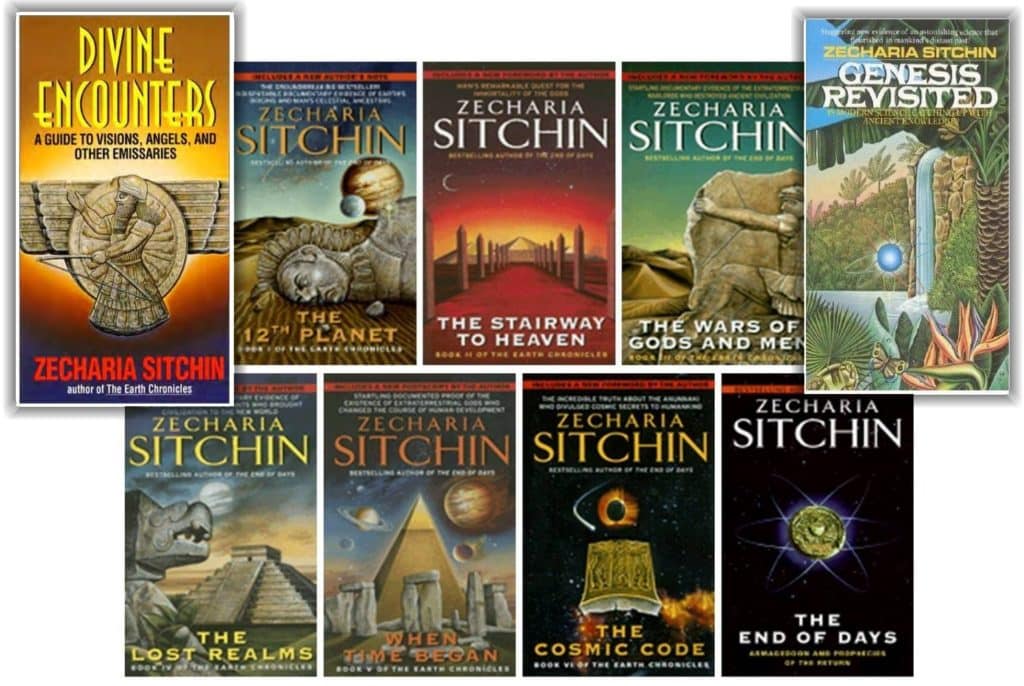
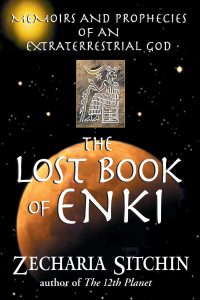
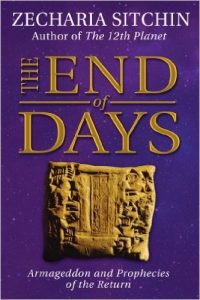
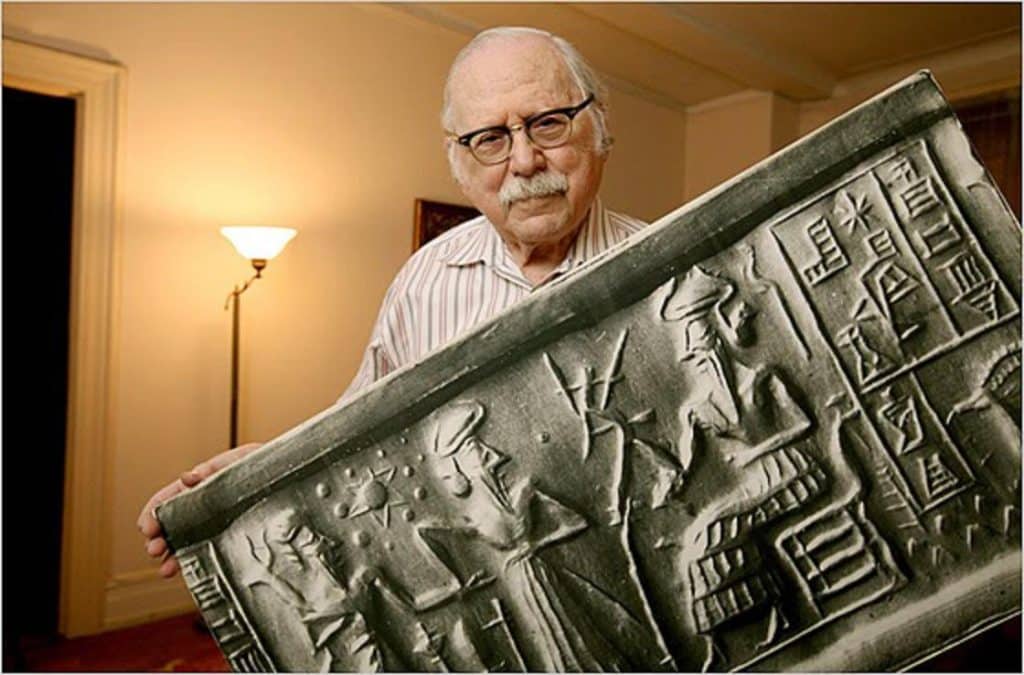
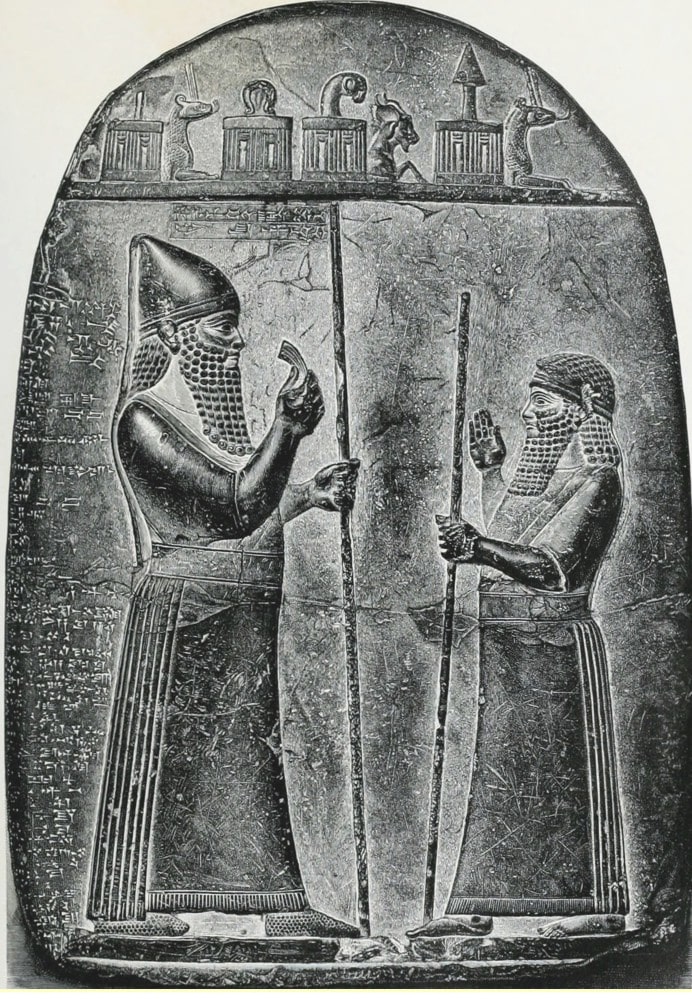
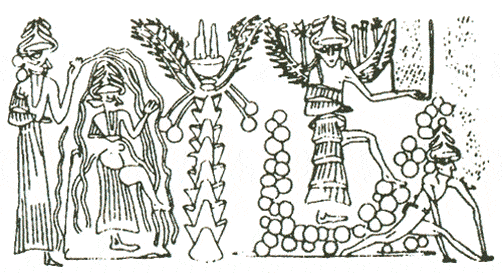
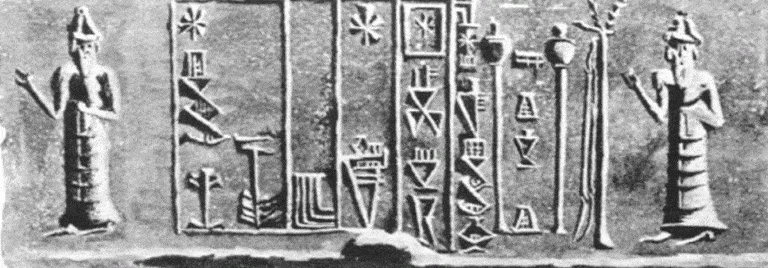

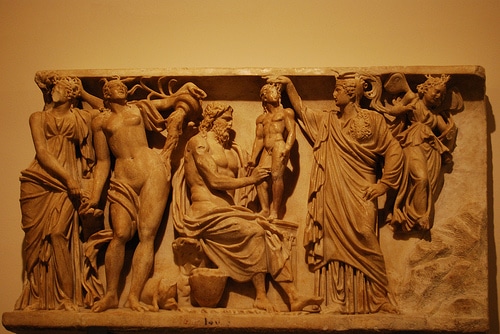
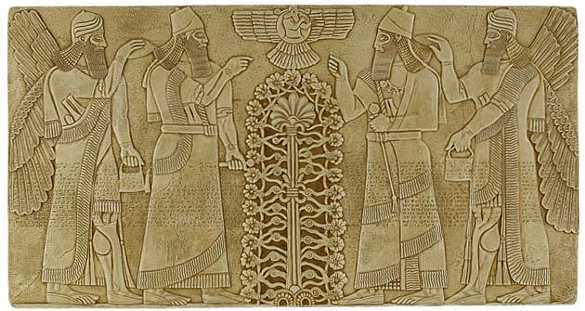
I read all Velikovsky’s books, and I don’t remember him mentioning “ancient aliens” at all.
Also, who says the “Sumerian Dictionary” is 100% correct.
Dr. Velikovsky was the first person to make sense of the old testament for me and Mr. Sitchin carried on where he left off.
Finally, carry on the good work.
Is anyone aware of contact with Mr. Sitchin since his death? Could be fascinating!